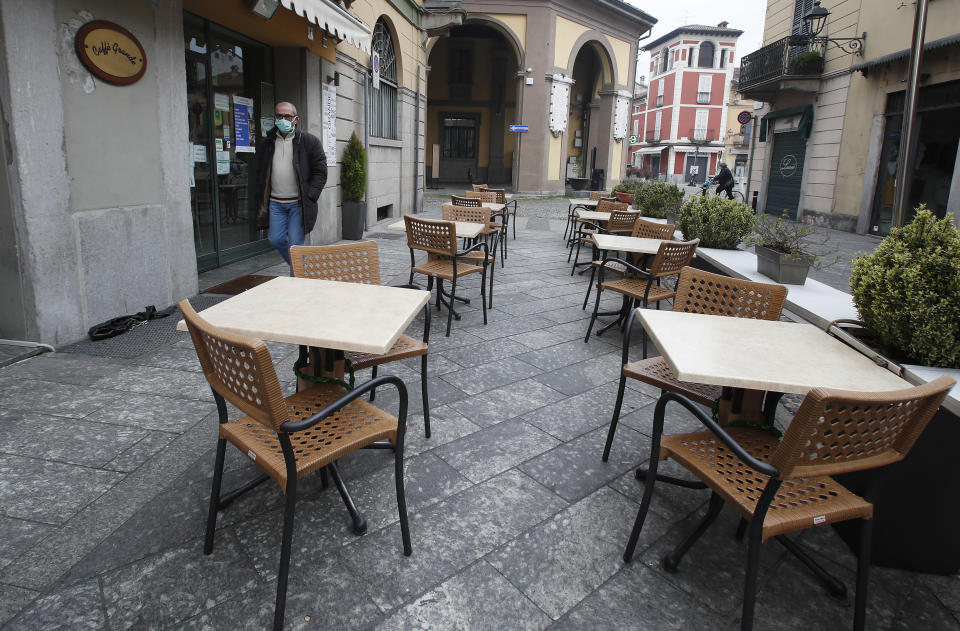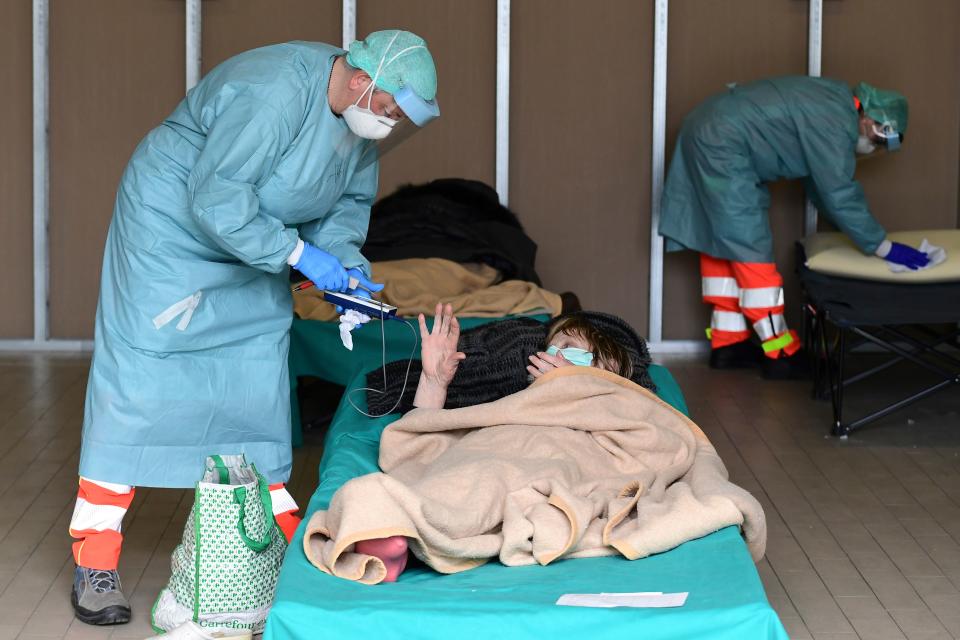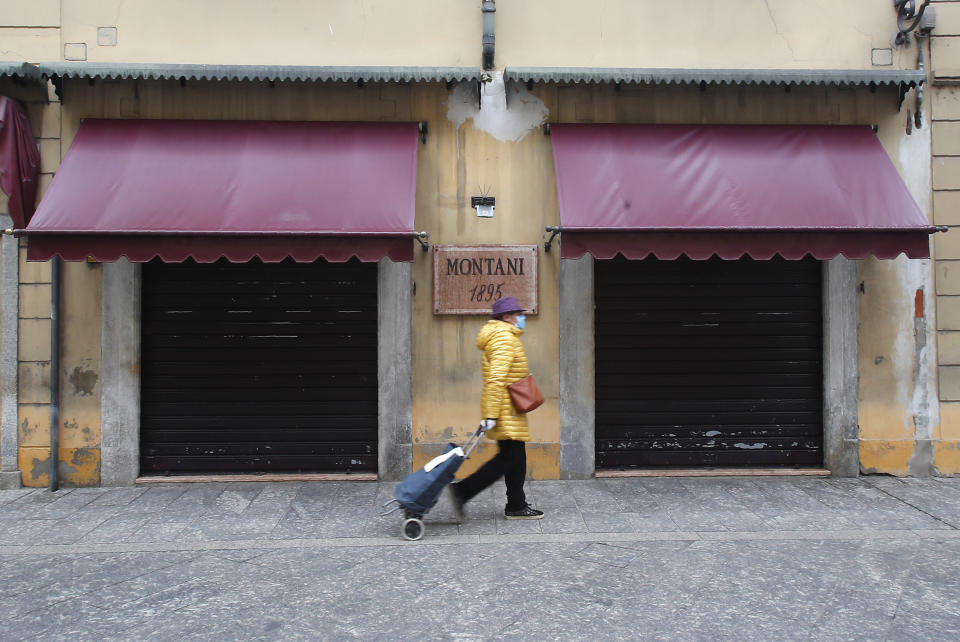Life under lockdown in Italy: A look at what might be coming to the U.S.
The epicenter of the coronavirus outbreak has moved from China to Europe, and within Europe, Italy has been hit the hardest. It struck first in Lombardy, in the north, but the national government has now imposed stringent quarantine regulations on the entire country of 61 million. Augie Kymmel is an American who has lived in Italy for 30 years, and she has filed this report from Cerete, a village in the province of Bergamo, northeast of Milan, not far from the border with Switzerland.
CERETE, BERGAMO, ITALY — Today is Friday, March 13, not an unlucky day in Italy, where Friday the 17th is jinxed. I woke up feeling more upbeat.
A wide-body Airbus A350 landed last night at Rome Fiumicino with much-needed medical supplies, including precious ventilators and masks, courtesy of the Chinese Red Cross. This morning I found out that not only was it carrying 31 tons of equipment — enough for 30 ICU wards for COVID-19 patients, as reported by China Daily — but also nine expert doctors and nurses with experience in tackling the disease.
If China can provide Italy with urgent medical assistance, Italy will be able help other countries in dire need. In fact, it was widely reported that the Bergamo hospital already shared its emergency model during a video conference with doctors in the U.S. who had participated in the Harvard Medical School Surgical Leadership Program.
I had been looking for an explanation for the high death rate in the Bergamo suburbs: Was it a more virulent coronavirus or the older population? This morning, reading an interview in the Corriere della Sera, I finally found a potential answer that gave me hope that many fatal cases could be avoided with the help of family doctors and social workers. A nephrologist working at the Bergamo hospital believes this coronavirus strain has been mutating quickly, probably since last December, when doctors in the area first noted more serious cases of pneumonia than usual. What’s more, ill people are afraid to go to the hospital, and instead stay at home taking acetaminophen and antibiotics for as long as they can, until they can no longer breathe.

Although we’re just at the start of our lockdown, which will remain in effect until at least April 3, most residents in our area seem willing to go along with the new travel restrictions and stay home. There’s not much of a choice, since all cafés, restaurants and nonessential retail businesses have been closed since March 12; schools and other venues were shuttered previously. Essential businesses like factories are open as long as workers are separated by at least 1 meter. Personally, I haven’t heard any major complaints yet. I think most of us are pretty scared by the relentlessly climbing coronavirus positives. Families here are already used to eating home-cooked meals, but stopping by a café for an espresso and chatting with friends will soon be sorely missed. Up until this week, students were able to hang out with their classmates after finishing their live-streamed classes and/or online homework; now they have to rely fully on their cellphones to keep in touch. Taking a walk or running is allowed, if you maintain the required 1-meter distance. We’re in the countryside, so there is plenty of space, unlike in the cities where young people, in particular, have no place except parks to escape to. Police officers there have been checking self-declarations — required for any kind of travel, even on foot — and breaking up groups congregating in green areas. Some cities have already locked their gated parks. Last I heard, more than 2,000 tickets have been issued to Italians for unjustified travel not related to work, health or emergencies.
Masks and disinfectant have been out of stock all over northern Italy for weeks. People who are lucky enough to have a mask or two at home have begun wearing them. This morning I emailed an order to the Cerete pharmacy and was pleased to find out that they now have hand sanitizer. Still no FFP2 masks though.
In my village and others in the area, the town government has teamed up with local pharmacies, grocers and café owners to provide free delivery of food and medicine to residents over 65 and people with disabilities who are unable to leave their homes during the lockdown or fear they will be infected. Young volunteers are providing door-to-door service.
To rescue the overloaded Lombardy hospital system, military doctors and nurses have been brought in and retirees have returned to work. Doctors from other parts of the country who are willing to take on the risk are hired overnight. Universities in the region have arranged for as many as 250 nurses to graduate early this year to supplement the existing staff, not only to manage the ever-growing patient load but also to substitute for workers who are now in quarantine or intensive care.

Another bit of potentially good news: The evening’s figures indicate that the number of new coronavirus positives may be decelerating.
The Ministry of Health reported 17,660 total cases in Italy, a rise of just under 17 percent (2,547) compared with a rate of 21 percent on March 12. Hospitalizations have dropped to 7,426, with 1,328 in intensive care. Total deaths are 1,266 and recoveries, 1,439.
In Lombardy, there are now 9,820 total cases. However, the rate of increase has greatly fallen off to 12.5 percent (1,095) compared with 20 percent on March 12.
One thing that can be learned from Italy is that everyone needs to take preventive measures before an area becomes a hotspot. An Italian study conducted by a group of scientists in Milan has shown that the first coronavirus to arrive in Lombardy could have originated in Germany and circulated undetected for more than a month before surfacing with a vengeance in Codogno, Italy, on Feb. 21. As early as mid-January, doctors in that area were aware of an unusually large number of pneumonia cases, which they now realize were mistakenly attributed to the flu or seasonal factors like the very dry weather. Back in February, many Italians waited too long before calling their family doctors, not only causing their condition to worsen, but also allowing them to infect many others.

As is already known from the cases in Italy and the U.S., fragile senior citizens, especially those living in crowded nursing homes, are at risk during the COVID-19 epidemic and can be infected both by visitors and staff. In Lombardy, visitors have been banned from nursing homes, except for urgent needs, since the government decree of March 4.
But not only the elderly should stay isolated at home (or outdoors) to protect themselves and others from the coronavirus. ISS, the Italian National Institute of Health, has recently found that the age breakdown of COVID-19 positives is as follows: 1.4 percent under 20, 20.6 percent from 20 to 49, 35.3 percent from 50 to 69, and 42.8 percent 70 and over. The average age is 64, and 60.4 percent are men. Of total cases analyzed, 26 percent, including children, have been hospitalized: 21 percent with severe symptoms and 5 percent, critical. In general, recovery takes a long time and demands resources that are in short supply. Lombardy’s so-called patient No. 1, a 38-year-old previously healthy amateur athlete, has finally been moved out of intensive care to a less critical unit — after a 3-week stay hooked up to a ventilator.
My brother-in-law thinks the invincible younger generation finally woke up and started paying attention this week when the Italian football championship was canceled. Live-streamed closed-door matches didn’t work because the fans gathered together to watch them. So the government apparently made the right move!
Silvio Brusaferro, president of the ISS, says we will know if the epidemic is under control only at the beginning of April. That’s a long time to wait.

_____
Read more from Yahoo News:

 Yahoo Finance
Yahoo Finance 


